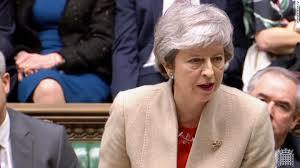British lawmakers on Friday rejected Prime Minister Theresa May’s plan for withdrawing from the European Union for the third time, leaving her policy in ruins and the casting the nation’s politics into further confusion, with the scheduled departure date looming two weeks away.
Recall that in January, Parliament rejected her plan, 432 to 202 — a historic margin of defeat for a prime minister’s bill. A second vote on March 13 was another defeat, 391 to 242.
In Friday’s voting, the Parliament rebuffed her once again, 344 to 286.
The vote on Friday might have been Mrs. May’s last chance to succeed on the issue that has dominated and defined her time in office, and the result left open an array of possibilities, including renewed demands for her resignation and early parliamentary elections.
Parliament has twice rejected Mrs. May’s proposal, but this time there was a twist: Lawmakers were only voting on the withdrawal agreement, the legally binding part of the deal.
They have set aside, for now, a decision on the nonbinding “political declaration,” a statement of what both sides want in Britain’s long-term relationship with the European Union. The two parts were separated to get around a procedural rule that would have prevented Mrs. May from making a third attempt to get the deal through.
Mrs. May told Parliament that if Parliament approved the withdrawal agreement, it would still have to vote for a larger bill that would include the agreement — an assessment some Labour members disputed.
The withdrawal agreement sets the terms of a transition period after Britain leaves the bloc, while long-term arrangements are negotiated. It would last through the end of 2020, but could be extended for two years.
It lays out in detail the nation’s trade relationship with the bloc, keeping Britain tied, at least temporarily, to many European Union tariff, product and immigration rules, protecting trade ties and the rights of the bloc’s citizens who are already living in Britain.
This agreement also includes language dealing with the border between Ireland, a European Union member country, and Northern Ireland, a part of the United Kingdom — a confounding and divisive issue that has proved to be the biggest sticking point in Parliament.
At the moment, goods and people flow freely between Ireland and Northern Ireland. Under the withdrawal agreement, that arrangement would continue even if the two sides have not reached a long-term pact by the end of 2020, under a provision known as the backstop.
The backstop would keep Britain, and particularly Northern Ireland, tied to many European Union rules, to avoid building physical barriers on the border. That is anathema to many Brexit supporters, who fear that it could leave Britain permanently beholden to the bloc.

 Health & Fitness6 days ago
Health & Fitness6 days ago
 Aviation1 week ago
Aviation1 week ago
 Aviation7 days ago
Aviation7 days ago
 Aviation7 days ago
Aviation7 days ago
 Aviation7 days ago
Aviation7 days ago
 Aviation5 days ago
Aviation5 days ago
 Featured3 days ago
Featured3 days ago
 Crime4 days ago
Crime4 days ago

